Vine and climbing plants are excellent houseplants that allow you to bring nature inside. Hanging baskets with trained vines or simply placed in a pot on a high shelf may benefit from the finest indoor vine plants and climbers. Indoor climbing plants with trailing vines and green leaves may fit into any interior design. Low-light environments, such as shade, gloomy rooms, and workplaces are ideal for trailing house plants.
How to care for indoor vine plants: Plant in a pot with well-draining rich soil, water when the soil is half dry, spray occasionally to boost humidity, and fertilize every month to develop thriving vine houseplants. The majority of indoor vines prefer bright, indirect light and temperatures of 65 to 85°F (18 to 29°C), but tolerate more varied conditions.
You’ll learn about the greatest indoor climbing vine plants available, as well as how to grow and care for them. Pictures and descriptions of draping plants you can grow indoors will be helpful when identifying them.
The Best Indoor Vine Plants (Overview)
Heartleaf philodendron—This universal vining houseplant thrives in poor light and may be utilized as a climber or hanging basket plant.
Ivy—Ivy, one of the most popular indoor plants with flowing vines, cascades down the sides of pots. Ivy plants thrives in the shade, and there are various kinds that suit growing indoors.
Devil’s ivy—Devil’s ivy, sometimes known as pothos, is a lovely climbing vine that grows indoors in hanging baskets. Everyplace will be brighter with the vibrant yellow and green leaves.
Inch plants—Inch plants have colorful bushy foliage and trailing stems and are very easy to grow indoors. Suspended from the ceiling in hanging baskets, on a high shelf, or draping off a tall plant stand, these Tradescantia plants make a stunning display.
Creeping fig—This vine-like stemed houseplant thrives in a variety of environments and grows rapidly. The creeping fig looks bushy in a hanging basket with foliage cascading over the pot because it is a spreading plant.
The Best Indoor Vines and Climbers (With Pictures of Houseplant Vines and Names)
Indoor vine plants and climbers that thrive in low light, bright light, and filtered sunlight are shown below.
Ivy Plant (Hedera)
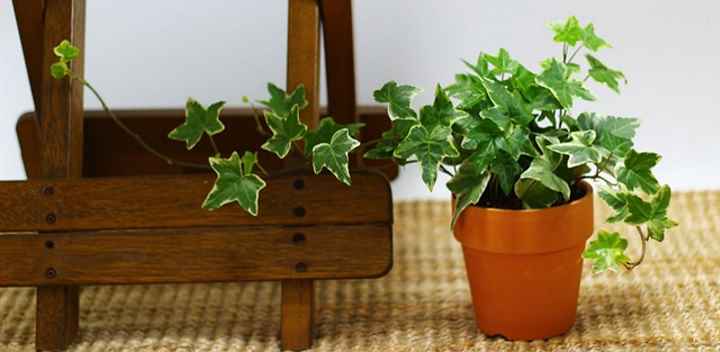
Ivy is one of the most popular indoor vines. These vine plants are superb at adding foliage in shaded areas and adjust to a variety of growing conditions. Even on dark winter days, the lovely evergreen leaves aid to brighten up indoor living areas.
Draping from hanging baskets or climbing vertically up trellises or moss poles gives all types of indoor ivy vines a nice appearance. Since they are simple to cultivate, tolerate infrequent watering, and don’t mind a little neglect, many individuals have ivy plants. It’s critical to recall that ivy plants are poisonous, and you should keep pets away from the draping vines. Long creeping vines are seen in a number of popular ivy plant species.
English ivy (Hedera helix)—The most common kind of indoor ivy vine, a fast-growing vining plant with evergreen leaves. The leaves are usually variegated with creamy-white or silvery patterns on dark green and shaped like a duck’s foot. This ivy is one of the best shower plants because it thrives in both filtered light and low-light environments.
Irish ivy (Hedera hibernica)—The ivy that grows on this tree is a fast grower with long trailing stems and lustrous green leaves. You may need to trim leggy vines to boost their attractive look while they’re growing in low light.
Japanese ivy (Hedera rhombea)—Another kind of fast-growing climbing house plant. This plant has larger oval leaves than English and Irish ivies, which are not lobed.
Algerian ivy (Hedera canariensis)—This climbing plant, also known as Canarian ivy, has broad, glossy dark green leaves.
Persian ivy (Hedera colchica)—The heart-shaped or elongated oval leaves of this ivy species are glossy. Of all the ivy species, Persian ivy has the largest leaves.
Swedish Ivy (Plectranthus verticillatus)

This isn’t a genuine ivy and it’s not from Sweden. This hanging basket plant is fake. If you want to grow an indoor vine plant without any trouble, however, Swedish ivy is a great option. Green oval leaves with scalloped edges cover the trailing stems.
Draping from hanging baskets or over the edge of a shelf, the spectacular foliage looks dramatic. In Swedish ivy, bright sunlight is not a necessary component of primary care, although it is recommended. Water when the soil is partly dry to help the plant thrive. Pinch off vine tips after blooming to prevent leggy stems from forming to promote development.
Devil’s Ivy (Epipremnum aureum)
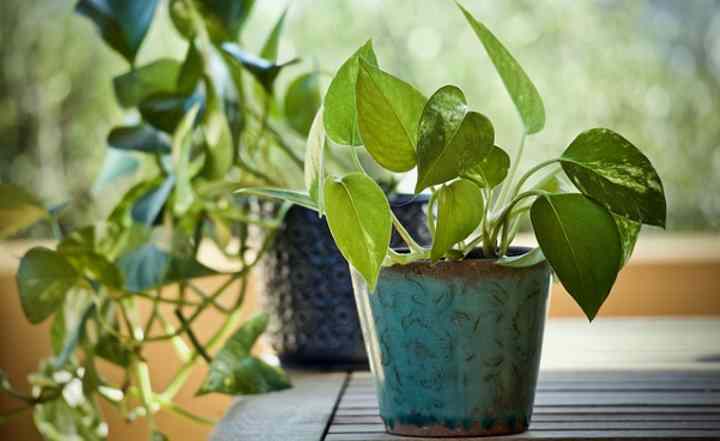
This is not a true ivy, despite its common name of devil’s ivy. Golden pothos, devil’s vine, marble queen, money plant, and Ceylon creeper are all terms used to describe species of Epipremnum aureum. Pothos is a beginner-friendly low-light houseplant.
The soil should be maintained slightly moist and the hardy vine thrives in bright, indirect light. The gorgeous foliage of devil’s ivy is coveted. Pothos plants with huge yellow and green leaves are available in several varieties. Neon pothos, a kind of this “ivy” plant with almost transparent leaves, is a distinct variety.
Heartleaf Philodendron (Philodendron hederaceum)

Another excellent low-light indoor hanging plant is Heartleaf philodendron. The leaves of this climber are big and green, with a lustrous sheen to them. The soil of sun-shy houseplants should never dry out, so they need just enough watering. The optimum growing circumstances seem to be low to moderate light and lots of humidity.
When hanging in a basket, the long creeping vines create vertical greenery. You may also teach the plant to climb up moss pillars or along walls. Heartleaf philodendron has a look similar to pothos plants, as seen in photographs.
Arrowhead Plant (Syngonium podophyllum)
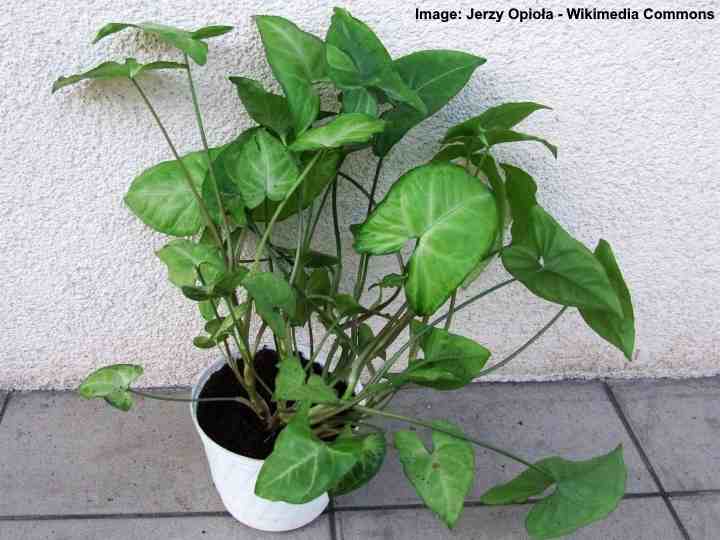
If you want bushy foliage in bright locations, arrowhead plants are some of the greatest indoor climbing plants. The broad variegated leaves of these hardy vining plants resemble an arrowhead in their form. The plant’s leaf form, also known as goosefoot or arrowhead vine, is another popular name for it.
Arrowhead plants have a creeping growth habit and do not need to be trimmed. As a result, long vines may dangle down beautifully when grown in hanging baskets. The vine plant may develop a bushier look with regular pruning. The lighter leafed types of arrowhead vines may develop well in shaded, low-light settings, while the brighter filtered light of arrowhead vines thrives.
Peperomia
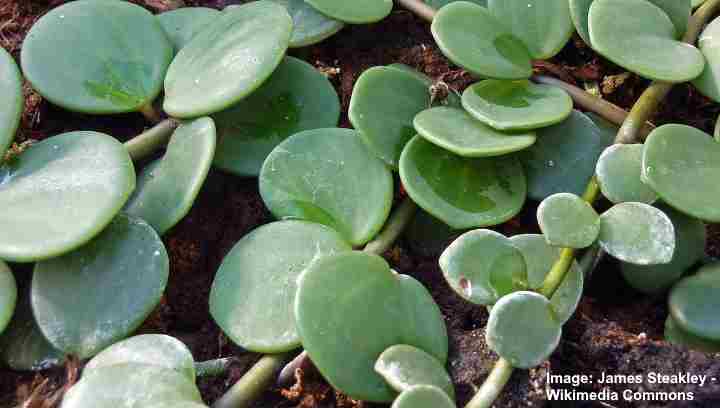
Peperomias are one of the most popular indoor vine plants, and there are several trailing types to choose from in this picture: Peperomia rotundifolia ‘Trailing Jade’. The foliage of these tiny houseplants is particularly excellent. Striped, marbled, or speckled leaf patterns are possible.
Oval, lanceolate, or ovate-shaped leaves may be seen on some of these trailing house plants. Because of its cascading foliage, a potted peperomia placed on a shelf or hanging from a basket creates a truly eye-catching visual element.
What’s the best way to look after peperomias? Water when the soil is mostly dry, and spray occasionally, place the container in a bright area. In low light, peperomias develop foliage that loses some of its brightness.
Creeping Fig (Ficus pumila)

Creeping fig plants have long vines that cascade down like a cascading mound of leaves in a pot. One of the few vining types is the little fig Ficus pumila, which is the tiniest of all figs. If you put the plant pot on a desktop, shelf, or let draping stems dangle from a hanging basket, thin stems and small leaves create an appealing appearance.
The crucial care requirement of creeping figs is plenty of bright light. They need thorough watering when the soil is partly dry, as well as a sunny spot.
Wandering Jew (Tradescantia zebrina)
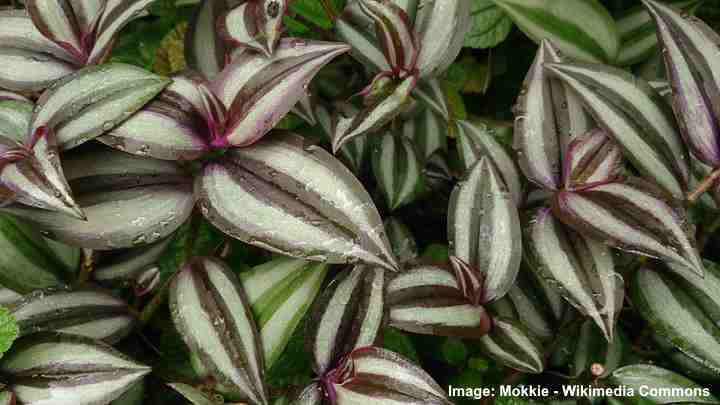
The wandering Jew is a trailing houseplant that’s also known as inch plants or spiderwort. Tradescantia plants come in a variety of species, all of which have intriguing foliage. Wandering Jews have attractive features, such as blade-shaped patterned leaves adorning their long creeping stems.
Purple plants with intricate variegated lilac and silver patterns are some examples of wandering Jews. Stripe leaves are dark green and light green in some varieties. Hang a purple-foliaged Tradescantia plant in a hanging basket to create an attention-grabbing plant feature. The blooms are small when compared to the plant’s gorgeous leaves, despite the fact that it is a flowering plant for hanging baskets.
Black-Eyed Susan Vine (Thunbergia alata)

If you want green leaves and dazzling yellow or orange blooms, choose the black-eyed Susan vine as a vining houseplant. Its stems may grow to be 3 to 6 feet (0.9 to 2.4 meters) long in pots and hanging baskets, making this sun-loving vine ideal for them.
Hanging black-eyed Susan plants in a hanging basket allows you to enjoy them outdoors throughout the summer. You may also train their stems to climb up trellises by growing them in pots. The most prevalent flower color among these blooming vine plants is yellow. Plants with pink blooms, as well as orange, cream, and light yellow blooms, may also be found.
Maidenhair Vine (Muehlenbeckia complexa)
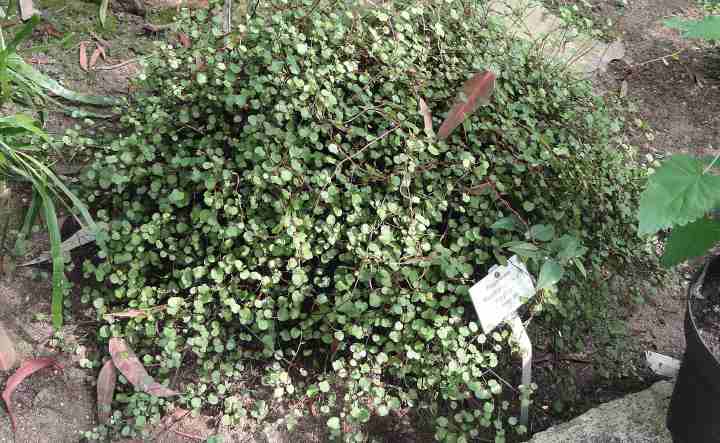
Maidenhair vines are ideal for indoor vines because of their creeping nature and lovely green leaves. Angel vine, necklace vine, lacy wire vine, and creeping wire vine are all terms for this native New Zealand plant. The slender, wiry foliage that develops densely into a small bushy plant is referred to by these common names. Its tangled growth habit gives it a thick appearance.
This vining plant can be used in a variety of ways to brighten up a room. To add greenery to a well-lit corner, hang it in a basket. Let the vines cascade over the pot to cover a area when growing in a container. Alternatively, place a trellis or moss pole beneath the climbing vine.
Teddy Bear Vine (Cyanotis kewensis)

One of the most interesting indoor vine plants you may cultivate is Teddy Bear Vine. Unlike any other trailing houseplant, the plant has foliage. Long, creeping stems have silvery green leaves that resemble a tear on them. As they grow longer, the soft foliage tumbles over the pot’s edges.
Hang or put in bright, indirect light to keep the foliage vibrant and colorful. Teddy bear vine is a indoor vine that takes time to grow. There isn’t much else you have to do to take care of it except watering enough to prevent the soil from drying out.
Betel Leaf Plant (Piper sarmentosum)
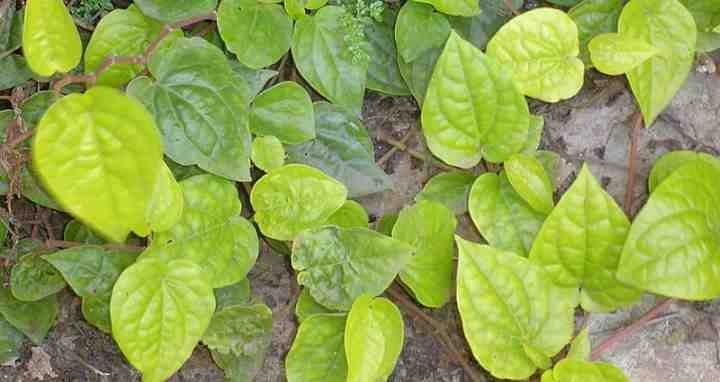
Betel leaf has thin, heart-shaped leaves that are glossy and have a perennial climbing habit. The vining plant, sometimes known as the pepper leaf plant, is native to India. In order to add a bit of “kick” to local cuisine, the spicy leaves are frequently used in cooking.
The vines dangle from the side of a hanging basket or container to create foliage. Grown in moist soil, place the potting soil in a sunny position with partial shade, and water only when the potting soil is mostly dry to care for a vining betel leaf plant. This is a great groundcover creeper plant for warmer climates.
Jasmine (Jasminum polyanthum)

While it is more difficult to establish than other indoor climbing plants, Jasmine is a vine plant that you may establish indoors. The distinctive kind of flowering jasmine that is most often cultivated indoors is Jasminum polyanthum. The fragrantly scented white blooms, dark green leaves, and strong development of jasmine plants make them popular. These vines have a climbing and spreading growth pattern.
Jasmine should be placed near a south-facing window when being grown as an indoor vine plant. They provide a low trellis for support since they are climbers. It’s best to expose your jasmine pot to the elements during the summer. To create blossoming buds that bloom in February, they need cool autumn temperatures.
String of Pearls (Senecio rowleyanus)

String-of-pearls is a succulent plant with bead-like leaves and slender dangling vines. Senecio rowleyanus is also known as string-of-beads. It’s simple to see how this vine plant got its name when looking at photographs of it. Pearls are simple to maintain at home because they don’t need much water – they’re on the list of hanging houseplants that require minimal care.
All you have to do is put the plant in a bright area with enough sunlight for a few hours every day. The slender thread stems dangle down from these draped indoor plants, creating a stunning waterfall effect. In a mixed hanging basket garden with other drought-tolerant plants, you may also plant string-of-pearls.
String of Hearts (Ceropegia woodii)
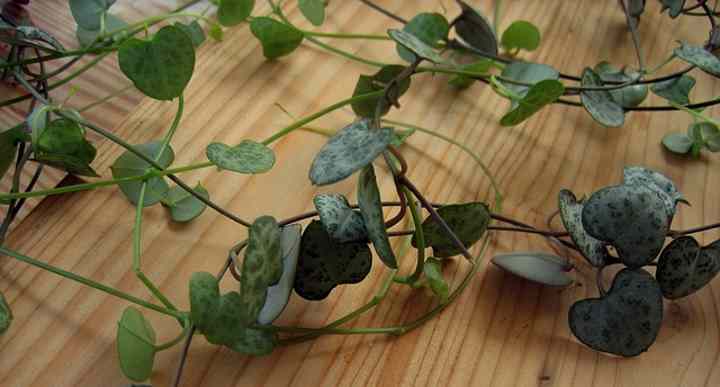
Another indoor trailing plant with thread-like stems and heart-shaped leaves is string-of-hearts. This plant is also a type of vining succulent and is commonly known as rosary vine, chain of hearts, or sweetheart vine. Place the houseplant vine in a bright location to view the stunning colors on the delicate leaves.
Since the trailing vines hang down 6 to 13 feet (2 to 4 meters), you can simply place a string of hearts on a high shelf. The other distinguishing feature is the manner in which the leaves grow on the stringy stems, in addition to the variegated silver and green leaves.
These leafy beads look like a long string of beads that are strung apart. One of the best plants for hanging baskets is this indoor vine plant. Water only when the soil is dry and keep in bright light to care for a string of hearts.
How to Care for Indoor Vines
Bringing the outside indoors with beautiful vine plants or climbing house plants. The air is also filtered by many indoor houseplants. There are a few things to remember when caring for trailing or creeping indoor plants, even though they are low-maintenance.
Light—Houseplants prefer bright, indirect light to avoid direct sun and flourish best in this kind of environment. Low-light or shade is also ideal for tropical houseplants. If the light is insufficient, they may not blossom, and their colorful leaves might fade.
Watering—Potting mix should be well-draining and include plenty of organic matter because they grow in pots. This kind of potting soil keeps the soil from becoming waterlogged or soggy while maintaining a sufficient moisture level. Allow the pot to drain completely before watering indoor vine plants.
Humidity and temperature—In typical room temperatures, indoor plants such as vineing houseplants and climbers thrive. Cold drafts, warm radiators, and direct sunlight should be avoided. Most common vine/climber plants cannot tolerate household air that is too dry. Therefore, by spraying the leaves on a regular basis, you may increase humidity. In order to help indoor vine plants thrive, you can also install a humidifier or use a humidifying pebble tray.
